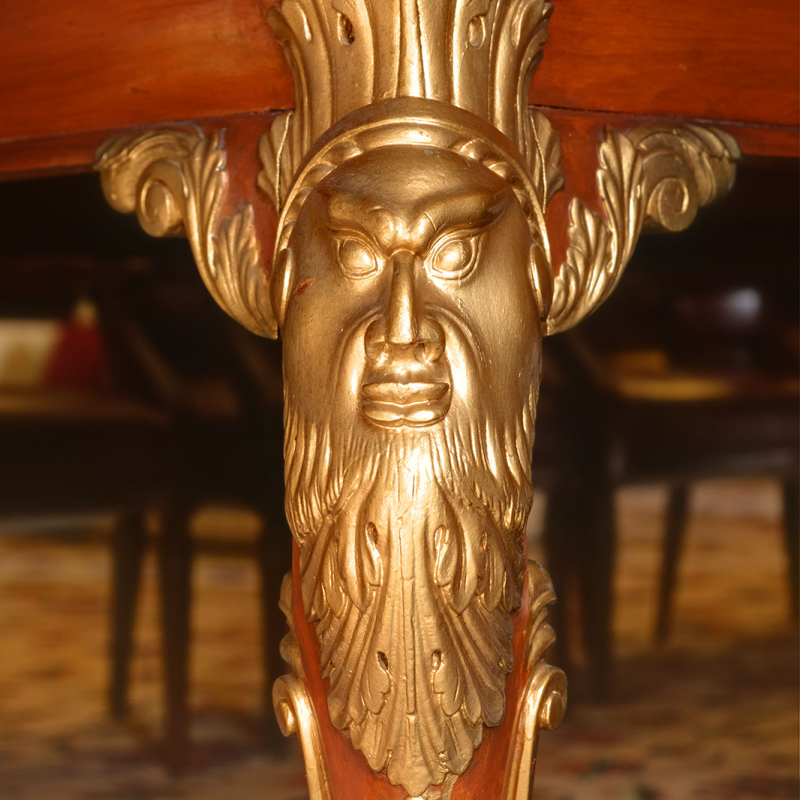Eclectic appointments for a modern state home
Lutyens admired the French for their strong concern for lasting substance and consistency in style and hoped that the furniture of the Viceroy’s House, later the Rashtrapati Bhavan, would exist as a longstanding monument to his work and design. Unfortunately for him, the site as he envisioned lasted only a few years, as even he could not account for the changing tastes of successive inhabitants. Lutyens may have tried his utmost to maintain a quality of unified design vision in the face of opposition from many interested parties but what he could not control was the fact that, ultimately, the Viceroy’s House was a domestic space that was subject to repeated and ever changing inhabitation. Between 1929 and 1947, five viceroy/vicereins lived at the Viceroy’s House, each with their own opinions on matters of domestic style.
The ‘Furniture’ at the Viceroy’s House consisted of the totality of the built interior environment including clocks, mirrors and even door knobs designed with detailed instructions, including many elements that could be sourced locally. The gargantuan task of covering as many as 370 rooms and an area of 200,000 square feet, took 12 years to complete (Richardson 1995). Lutyens made as many as 19 visits to Delhi, spending between three and five months away at a time. It is known that examples were shipped over from England to serve as ‘aide-memoires’, and there is substantial evidence that Lutyens set up ateliers in Delhi and Lahore employing local craftsmen.
A significant part of the furniture at the Viceroy’s House was designed in a manner that would have been familiar to both its inhabitants and many of its guests. This was expected of Lutyens who, prior to his appointment, had maintained his practice by designing country houses for the English aristocracy. In an era of raging modernism, Lutyens provided an alternative to the use of stark lines, concrete and strong horizontals. Calling this ‘inhuman’ he felt people would ‘lose the pleasure of thick soft walls, when compelled to live in stark noisy boxes’. Instead, Lutyens wished to produce furniture that would speak to the design language of the country house. He turned to elements previously utilised in his actual country house work, as well as borrowing significantly from the published work of designer and author Percy Macquoid.
Furniture of state
As much as it was a domestic residence, the ‘Viceroy House’ served as a space of international diplomatic protocol, reflected in the furniture choices. The ‘Grand Manner’ design sensibility employed throughout the site deliberately aligned it with major capitals like Rome and Paris for whom lineage had come through the annals of time (Kostof 1991). Nowhere was this more apparent than in the Durbar Hall, the room dedicated to communal speech and the physical expression of the British seat of power. The Roman allusions continued with a sideboard now found in the corridor leading to the Durbar Hall. The metalwork additions represent the Capitoline Triad of Jupiter, Juno and Minerva symbolic of Rome’s illustrious history and its imperial tradition.
The staging of ‘pomp and delight’ was key to making the power of the British reign physically manifest and a particularly overt exhibition of this were the viceregal thrones within the Durbar Hall. These were flamboyant gold and crimson creations, each topped by a crown and two lions, and surrounded by luxurious curtaining and baldachin. A lasting legacy of the Viceroy’s House project is that many of the pieces show a unity of conception between the furniture and the larger projects. Lutyens achieved this by working at both the macro and micro scales, including the repetition of certain design elements within the furniture. Favourites included geometric shapes, the bell, several versions of friezing such as Romanesque and Chinoiserie inspired as well as the use of bun feet and some more demonstrably ‘Indian’ elements. Even today, viewing what remains of the furniture designed by Lutyens, one cannot but note the definitive visual vocabulary that was implemented within the house.
On August 15, 1947, Earl Mountbatten of Burma became the Governor General of the Dominion of India. The ceremony took place in the Durbar Hall, and while the coat of arms denoting British rule was removed from the exterior, no such effort was made to make any amendments to the viceregal thrones. The thrones were subsequently removed and replaced with an example more ‘fitting’ for a modern independent nation, replete with a renewed symbology, including the Ashoka chakra.
References
Rashtrapati Bhavan archives
‘Extract from a private letter from his excellency the Viceroy to the Right Honourable the Baron Olivier of Ramsden, P.C., K.C.M.G., C.B., His Majesty’s Secretary of State for India,’ October 9, 1924, File 765Gen/28.
Published works
Herbert, Eugenia. 2013. Flora’s Empire: British Gardens in India. London: Penguin
Kostof, Spiro. 1991. The City Shaped: Urban Patterns and Meanings through History of English Furniture. London: Thames and Hudson.
Macquoid, Percy. 1988. A History of English Furniture. London: Bracken Books.
Moore, Abigail Harrison. 2011. Fraud Fakery and False Business: Rethinking the Shrager Versus Dighton ‘Old Furniture’ case. London: Continuum Publishing Corporation.
Observer. 1928. ‘The Robotism of Architecture’, The Observer, January 29.
Richardson, Margaret. 1995. Sketches by Edwin Lutyens: Drawings from the Collection of Royal Institute of British Architects. London, NY: Academy Editions.
Singh, Khushwant and Nandini Mehta. 2011. Not a Nice Man to Know: The Best of Khushwant Singh. New Delhi: Penguin Books.












